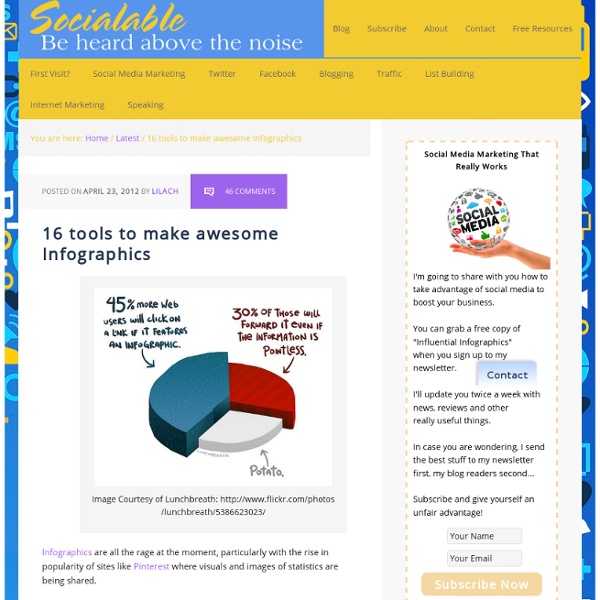The 16 best tools to make awesome Inforgraphics
Lilach Lilach is the founder and driving force behind Socialable, and highly regarded on the world speaker circuit. Forbes and Number 10 Downing Street have even been graced by her presence! After launching her first business within three years of becoming a mother, her financial success was recognised by being a finalist at the Best MumPreneur of the Year Awards, presented at 10 Downing Street. A business owner, social media consultant, internet mentor and genuine digital guru, Lilach is consulted by journalists and regularly quoted in newspapers, business publications and marketing magazines (including Forbes, The Telegraph, Wired, Prima Magazine, The Sunday Times, Social Media Today and BBC Radio 5 Live). When Lilach isn’t working she enjoys spending time with her family and is an avid fan of Zumba.
Infographic Creation Made Easy with Visual.ly Create
Today marks an important milestone for Visual.ly: the release of our tools for automatic infographic creation. Our team has made hundreds of infographics, so we know how hard it can be to find the data, do the necessary research, and make sure you are following the principles of good data visualization, while still coming up with a design that people will want to hang on their wall and spread through the interwebs. That’s why we’ve built data feeds into a number of infographic designs, created for you by our team of expert designers. Making an infographic, based on your own data, couldn’t be easier. Simply connect and click to produce a professional-looking infographic. If you don’t like the first design you try, click though the themes until you find one that you do like. We are social creatures, so we thought it only natural to start with Twitter and Facebook. Another reason was our launch at the SXSW Festival, a place where many new stories are being told.
Les 4 catégories de brand content - TRIBUNE
Voici une typologie en 4 catégories mises à jour avec le sémiologue Odilon Cabat. Cette nouvelle typologie vise à apprécier l’autonomie du contenu créé par la marque. Le premier cercle est directement lié au champ de la marque par les usages. Le deuxième s’élève pour considérer les lieux de la marque. 1 : des contenus informatifs directement liés aux usages du produit (recettes, conseils,…) Le but est d’offrir un contenu qui se rapproche au maximum de l’usage du produit. L’idée est d’associer un texte et des images à la prise en main d’un produit, dans un but purement informatif, qui diffère de la communication. Modes d’emplois, recettes de cuisine par Picard ou Daddy, conseil bricolage de Castorama, conseils en matière de placement par les banques, tous les contenus qui relèvent de la relation pragmatique aux produits et aux services relèvent de ce premier type. 2 : développer des lieux sous l’emprise de la marque Faire de la visite une expérience Manger le pain des marques
How to Increase Consumer Loyalty with Brand Affinity
Apple is a cult brand. It’s the world’s most valuable technology company and has produced some of the bestselling products in the technology industry. Have you ever wondered what makes Apple customers loyalty one of the best, if not the best, in the world – is it great products, brand affinity, a lethal marketing team or a combination of those factors? In my opinion, Apple is perhaps the best example of how brand affinity can boost a company’s customer loyalty in an unparalleled manner. Brand is everything The best thing about Apple’s success is that the Cupertino giant has given the due emphasis to the ‘Apple’ brand. Honesty Apple is a remarkably honest company. Cult It’s not just about a brand name. Promotion Apple’s marketing is in a unique league of its own. What’s your take on how brands can increase customer loyalty through brand affinity? Douglas Idugboe Douglas Idugboe, Digital and New Media Marketing Strategist. Latest posts by Douglas Idugboe (see all)
How to Create and Manage Your Brand Online
Why should you worry what people say about you or your brand online? You’re already doing an awesome job for your clients, people who know you professionally and personally recognize you run a terrific company, right? Do you use user reviews / local search sites such as Epinion, Yelp etc? Why do you use them? You use them because what people say about you matters. Creating and managing an online reputation is a vital part of defending your company’s brand. Here are some tips for creating and managing your brand: 1. Create social media profiles on LinkedIn, Facebook, and Twitter that include your company’s name. 2. I see lots of people left out on this one. 3. Besides engaging with people on the already mentioned social media and networking sites, it’s quite important to connect with bloggers who blogged about your company. 4. Monitoring what people are saying about your company is the pivotal step to managing your brand. Conclusion: About the Author: Name: A.R.Karthick
Related:
Related:



